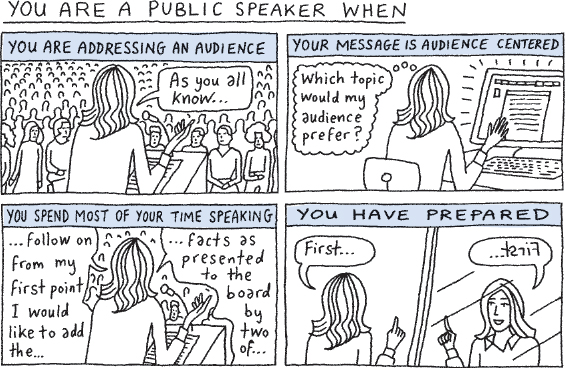INTRODUCING PUBLIC SPEAKING
Printed Page 2
1
INTRODUCING PUBLIC SPEAKING

Look for the  throughout the chapter for online video activities at bedfordstmartins.com/speakup.
throughout the chapter for online video activities at bedfordstmartins.com/speakup.
 Public speaking is right for you.
Public speaking is right for you.
In 2008, Malala Yousafzai was a ten-year-old student in the Swat Valley region of Pakistan. After the Taliban prohibited girls’ education in the region in early 2009, Malala began to blog about the importance of education for girls. The British Broadcasting Company published her writings using the pseudonym Gul Makai (“corn flower”) for ten months. A year later, Malala began to speak in public to advocate for girls’ education—using her real name this time. She became well known around the world, especially after the New York Times featured her in a documentary1 and South African archbishop Desmond Tutu nominated her for the 2011 International Children’s Peace Prize.2
In October 2012, a Taliban shooter attempted to end Malala’s life. Though suffering a gunshot to her head, Malala survived, and the violent attack did not deter her from continuing to speak out. Four months later, as she recovered in a British hospital, Malala delivered a message to the public: “I want every girl, every child, to be educated.”3 She also announced the establishment of a new charitable organization, the Malala Fund, to help make her dream come true.
Malala Yousafzai’s story is a unique example of how public speaking can change the world. In more everyday situations, public speaking is still a vital skill for anyone looking to inform, influence, or persuade others—which is why it’s often a required course in colleges and universities. Public speaking is also highly prized in most professions.
For example, as the supervisor of a team developing a new video game, you may have to deliver a presentation to a group of managers updating them on the team’s progress. As a leader in a nonprofit environmental organization, you may need to give a talk during a major fund-raising dinner to influence potential donors to open their wallets. As a manager for a marketing firm, you may be called on to deliver a persuasive presentation on an online ad campaign to an important potential client.
Despite this, many college graduates enter the work world without any experience in public speaking. As Marilyn Mackes, executive director of the National Association of Colleges and Employers, noted, “For more than ten years, we’ve asked employers about key skills, and they have consistently named communication skills as critical, yet have also said that this is something many candidates lack.”4 A public speaking course helps you master skills that will enable you not only to advance in your career but also to excel in other courses (especially your major) and make valuable contributions in other areas of your life—such as community service and local politics.
Of course, you may find the thought of giving a speech terrifying. If so, you’re not alone. A survey by Whitworth and Cochran5 found that public speaking is Americans’ number one fear, while another researcher noted that many people find it “even scarier than rattlesnakes.”6 But there’s good news: you can learn to master public speaking—just as most people learn to read, ride a bicycle, or keep up with the latest technology. In our fifty-plus years of teaching public speaking, we’ve seen thousands of students gain confidence and lose their fear of public speaking as they acquire experience with it.
This book walks you through the steps you need to follow in order to create and deliver an effective speech—one that gets a favorable response from your listeners. In the chapters that follow, we explain each step in clear terms and show you how to make smart choices at each stage of the speech preparation process. We supplement these explanations with illustrations that depict key points—which, besides being entertaining, are designed to help you grasp and remember the most important concepts in the book.
But before we jump into the process of preparing and delivering an effective speech, we will take a few moments to explore the field of public speaking itself. In this chapter, we take a closer look at the benefits of studying public speaking. We also survey its rich tradition and consider the highlights of contemporary trends in the study of public speaking.

